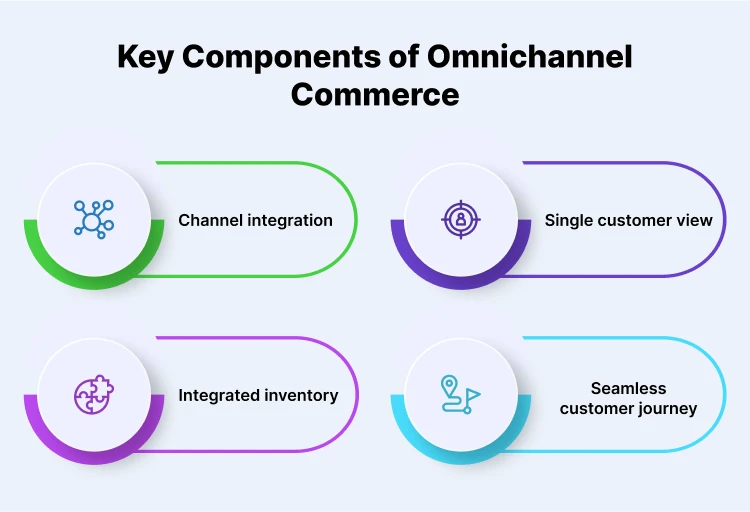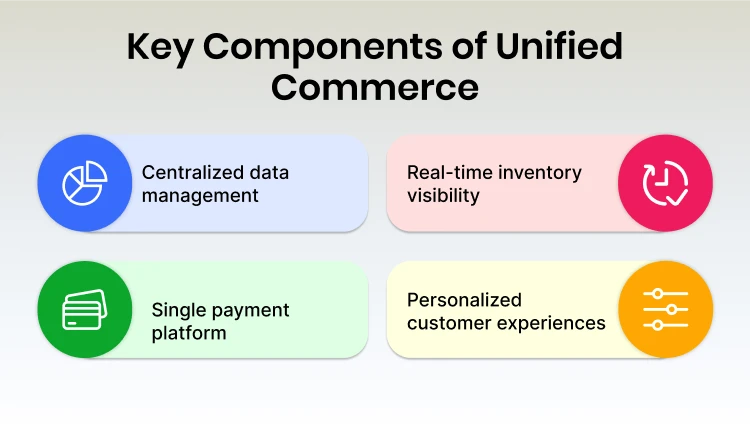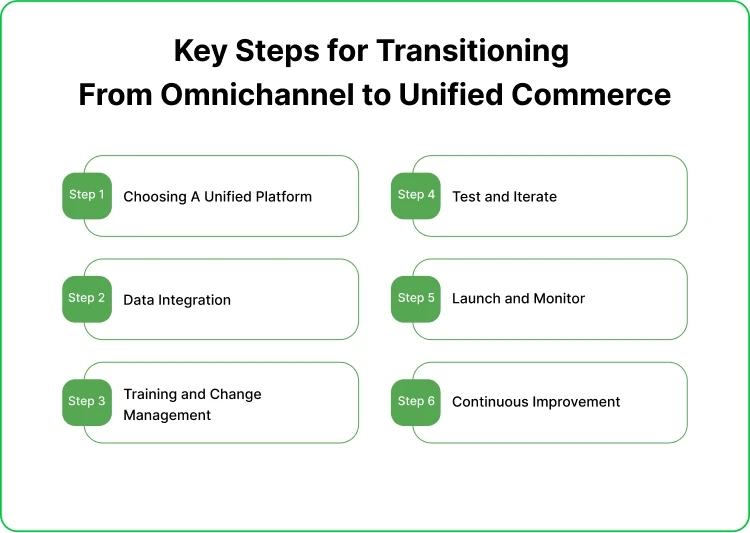 Business Solutions
Business Solutions

07 May, 2024

Businessmen are migrating to multichannel strategies like omnichannel and unified commerce to meet the evolving demands of customers. Though both of them focus on enhancing customer experience in multiple channels, they aren’t similar.
Let’s see an Omnichannel vs. unified Commerce comparison. Unlike omnichannel commerce, the unified one provides real-time data updates with higher accuracy and less complexity. Besides, the omnichannel is brand-centric, whereas unified commerce is customer-centric which integrates the channels with back-end systems.
Both of these commerce approaches have their benefits. Thus which one is better will depend on several factors. We will discuss those factors in this article, so tag along.
Contents
Omnichannel commerce refers to a retail strategy that integrates multiple sales channels, both online and offline. This helps in breaking down the barriers between different channels, such as brick-and-mortar stores, websites, social media platforms, etc.
If you follow a multichannel strategy, each channel will function differently from each other. However, all the sales channels communicate with each other in an omnichannel strategy. Thus, your customers can interact with your brand and make purchases through their preferred channels.
For example, even if your customers can purchase your product online, they can pick it up in-store. Also, they can return it in person or via mail to any of your store locations.

Here are the key components of omnichannel commerce:
For example, if your customer views any of your brand’s products on Instagram, the data will be saved. Whenever they visit your brand’s website, that product will be on their suggested product list.
Even, your customer can choose a product online and can purchase it from an offline shop.
Unified commerce refers to a retail strategy that consolidates all sales channels into a single, centralized unified commerce platform. Through this single platform, this commerce practice will connect your business’s back-end operations with front-end operations.
Here, these interconnected channels and central management will provide you with a holistic view of the customer and inventory. Besides, with the consolidated data insights, you can track your business performance and adapt business plans to upcoming changes.
This will also help you provide customers with a consistent experience regardless of the channel they use.
For example, your customers can research a product online, and then come to your retail store for a hands-on experience. After selecting any item, they can scan and see the product’s information, reviews, and discount offers. Real-time data from their online research to product delivery will be synchronized in this unified commerce.

Key components of unified commerce include:
The key differences between unified commerce and omnichannel commerce are:
| No. | Parameters | Unified Commerce | Omnichannel Commerce |
| 1. | Integration approach | Integrate all channels and systems | Integrate channels |
| 2. | Data updates | Real-time data updates in all channels | May fail to update data in real-time throughout all channels |
| 3. | Customer-centricity | Customer-centric approach | Brand centric approach |
| 4. | Implementation complexity | The integration process is less complex | Higher complexity in integrating new channels |
| 5. | Human error | Less human error | High rate of human errors |
| 6. | Efficiency | Higher efficiency | Lower efficiency |
| 7. | Adaptability | Higher adaptability | Lower adaptability |
| 8. | Transaction handling | Seamless transaction handling among channels | Transaction handling may vary among channels |
Let’s know more details about these distinguishing parameters:
A unified system generally integrates all the back-end systems with customer interaction channels. The operations of your business’s backend system aren’t visible to customers, but those are equally crucial. Luckily, unified commerce connects all the channels with the product inventory, customer data, payment, and delivery system.
However, omnichannel retailing consists of unconnected systems and channels and involves data silos for each channel. Though your customer may get a consistent experience from each channel, each of these will involve separate systems.
As you will have a single platform for your unified commerce strategy, real-time updates across all channels are possible. Hence, if a customer makes a purchase, the stock changes will be updated at all the touch points.
Besides, your customers will be able to see that update in real-time through any channels. However, when you follow an omnichannel strategy, all of your data is stored separately across different channels.
Thus, upon purchase, the stock updates won’t be in real-time as the former one. Sometimes, your customer may see a product in stock online, but find it out of stock in a retail shop. This type of discrepancy may cause a bad customer experience.
Whereas the purpose of unified commerce is personalizing customer service, the other one focuses on seamless customer service. The former collects your customer behavior from all the channels and processes them in a unified platform.
However, your omnichannel strategy may not be as personalized as the former one. Normally, it offers flexibility in channel interactions but may prioritize consistency over personalization.
Generally, omnichannel commerce is more brand-centric. Thus, it will track the customer interaction information with your brand in different touch points. According to those data, your customers will get recommendations over products.
Interconnecting multiple channels can be time-consuming and expensive for you in an omnichannel approach. You may require multiple software for CRM(customer relationship management), core system, E-commerce, etc. Also, integrating a new channel with the existing one is quite complex.
On the other hand, you will use cloud-native technology for unified commerce where integration of new channels is easy. Alongside, you can handle all the channels with more ease than the former one.
As you can operate the unified commerce system through a single platform, the chances of mistakes are less. But, in the omnichannel ones, information synchronization is quite complex, which raises the risk of human mistakes.
For example, inaccurate inventory tracking and order processing mistakes can raise customer dissatisfaction.
Unified commerce is more efficient than the omnichannel ones. Because, the stronger connection between offline and online points, increases efficiency in pickup, delivery, and return policy.
Though there exists integration between offline and online channels in omnichannel commerce, those channels operate independently. Thus, it may provide your customers with a consistent experience but not as seamless an experience as a unified one.
When your business is expanding, you frequently need to add new technology and features to existing ones. In this case, to reduce the complexity of integration, choosing a unified one over an omnichannel is preferable.
Because scalability in Omnichannel commerce may be limited by the complexity of integrating multiple channels. However, Unified One offers higher adaptability and scalability to evolving market trends and customer needs
In unified commerce, your customers can interact with your brand through their preferred channels without transaction process inconsistencies. All transaction data is synchronized in real-time across this system.
On the other hand, in omnichannel, transaction handling differs among the channels. Thus, when customers start or end a transaction in different channels, they may find limitations and difficulties.
Both omnichannel and unified approaches have their strengths and may suit different scenarios. Here’s a comparison to help you understand which one best fits your business goal and preferences:
Here are several advantages of omnichannel strategy:
Here are several benefits of a unified approach:
Omnichannel represents an initial acknowledgment of the multi-channel reality, whereas unified commerce will function as an omnichannel commerce solution.
Generally, Unified One will synchronize the data among all the channels and customers can make purchases without confusion. This provides a better customer experience.
Normally, 72% of customers won’t buy products from your brand if they encounter a bad experience. Another report says, 86% of customers abandon a brand over 2 poor service experiences.
That’s why your main focus should be on providing best-in-class customer service. In this case, Unified Commerce lives a level higher than Omnichannel.

When you are deciding to transition from an omnichannel to a unified commerce approach, follow these steps:
You must select a unified platform to scale up and integrate all your business channels. But, what is a unified commerce platform? This platform refers to a single centralized platform integrating backend data and providing a single source of truth.
Alongside this, consider factors such as integration capabilities, customization options, scalability, security features, and user-friendliness of the platform.
Omnichannel commerce already integrates multiple channels, you just need to integrate it with the back-end system. Hence, develop a data integration plan to consolidate customer, transactional, inventory, etc data from multiple sources into a centralized system.
Provide comprehensive training and support to employees to ensure a smooth transition to the new unified commerce platform. You need to educate your staff on the features, and functionalities of the platform.
Also train them on new processes, workflow, and change management strategies.
Conduct thorough testing and validation of the unified commerce platform to identify and address any issues or discrepancies. Also, you can take feedback from users to optimize performance and usability.
After launching the platform, you need to monitor its key performance indicators. For this, you need to monitor sales, customer satisfaction, order fulfillment, and operational efficiency. This will help you to assess the impact of the transition and make necessary adjustments.
Implement a process of continuous improvement to refine and optimize the unified commerce platform over time. The addition of artificial intelligence and blockchain technology can enhance the effectiveness of this commerce strategy.
If you compare Omnichannel vs. unified Commerce, you can easily decide which one is better. The unified one will provide a better flow of data among all the systems and channels. Thus, this aims to deliver your customers a frictionless shopping experience that meets their evolving needs.
Generally, the omnichannel approach is better than any single-channel or separate multichannel commerce. But, to ensure better efficiency, sales, growth, and customer loyalty, a transition to unified commerce is a wise decision. Due to developed technology, integration into a unified strategy is both easy and cost-effective.
In this FAQs section, we will answer several questions about Omnichannel and Unified Commerce:
Yes, you can, but both strategies may overlap in a few areas. However, your ultimate goal should be to transition to the unified system completely. But, during the transition, having some omnichannel strategies will eliminate risks and ensure a smooth transition.
The main challenge in this transition is technological complexities as it requires higher cost and expertise. Also, your employees will require training to adapt to the new process, technology, and change in management.
Implementation of AI can empower seamless delivery, and convenient, and personalized experiences across all channels. Because AI can give you insights by analyzing customer preferences and behavior. These insights will help you improve business strategies, and drive customer satisfaction.